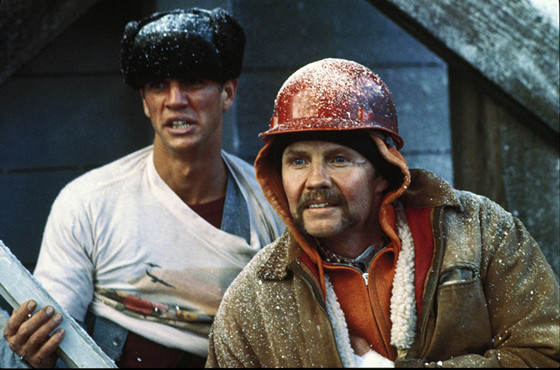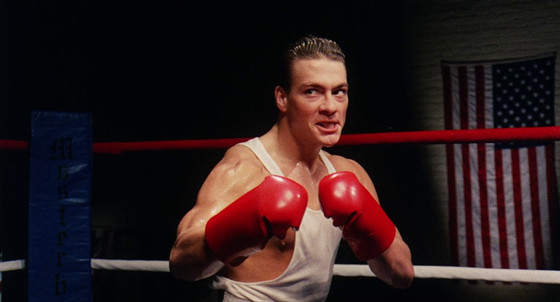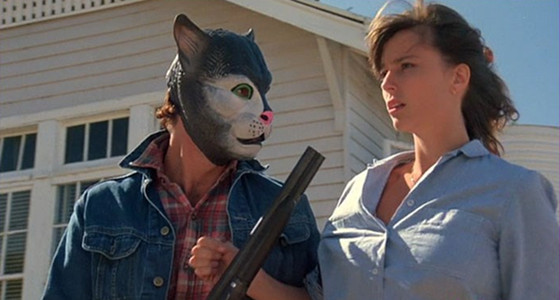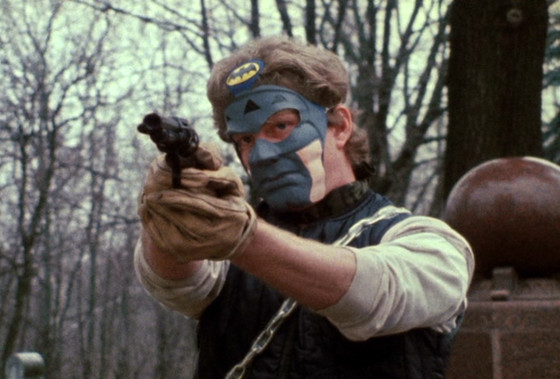6. Runaway Train (1985)

Runaway Train flaunts quite the pedigree. The script (co-written by Djordje Milicevic, Paul Zindel, and ex-con Edward Bunker) was based on an original screenplay by Akira Kurosawa, and the directorial reins were taken by Andrei Konchalovsky, a distinguished Russian filmmaker who had frequently collaborated with the great Andrei Tarkovsky.
A riveting mixture of American blockbuster action and intimate art-house sensibilities, Runaway Train tells the story of Manny (Jon Voight) and Buck (Eric Roberts), two incompatible prison escapees in Alaska who board a four-car train, destination unknown, stowing themselves away in a rear compartment. Moments after the locomotive begins its journey, the conductor suffers a heart-attack and the train furiously plows ahead, overriding the automatic stop mechanism and gradually picking up speed.
The film hops between Manny and Buck on the increasingly dangerous train (eventually joined by a stowaway railroad worker played by Rebecca DeMornay), transit authorities frantically trying to stop the out-of-control machine, and an angry warden (John P. Ryan) who is dead set on recapturing his two escaped prisoners.
What truly sets Runaway Train apart from other 80’s action films (particularly those from Cannon Group) is a strong emphasis on story and character. Manny is a hardened, ruthless bank robber, respected by his fellow criminals and destined for grand failure. By comparison, Buck is youthful, excitable, talkative, possibly holds some glimmer of hope in his future: he’s Manny’s polar opposite.
Voight and Roberts (both of whom received Oscar nominations for their work here) create two extremely compelling characters, and their dialogue is wonderful. Runaway Train didn’t short its characters in favor of non-stop excitement, but its careful to deliver both.
The action scenes, unbearably tense and impeccably crafted, are as riveting as those in any other film. No CGI, real metal and steam, real locations, a legitimate heap of hulking metal barreling towards the camera; you can practically feel the heat from the diesel engine.
Runaway Train is a class act, across the board. It suffers from a few minuscule flaws (Rebecca DeMornay’s character is 100% disposable), but they don’t keep Runaway Train from being a towering classic of cinema. Unquestionably the finest feature ever released by Cannon, it’s one of the best action films ever made. Movies in this particular genre don’t get much better. The final shot will stay with you forever.
7. No Retreat, No Surrender (1986)

No Retreat, No Surrender was a ‘first’ for many involved in its creation. It was the debut stateside effort from Hong Kong actor/director Cory Yuen. The writer, an American named Keith Strandberg, had never before written a screenplay (by his own account, he hadn’t even read one). It also marked the on-screen debut of Jean Claude Van Damme, and practically everybody else in its cast. Upon viewing the finished film, none of this comes as a surprise.
As entertaining as No Retreat is – and trust me, it’s an absolute blast – it’s very poorly made. Example: the main characters discuss an upcoming move to Seattle. We then cut to a shot of their car passing a roadside sign, ‘Welcome to Seattle’, and next a shot of the world-famous Space Needle, accompanied by a title card reading, ‘SEATTLE’. That’s the kind of film we’re dealing with.
The (wildly derivative) plot involves Jason Stillwell, a teenaged Bruce Lee fanatic who desperately wants to win a local Kickboxing tournament. He’s aided by his pal RJ, a breakdancin’, rappin’ cliche straight outta 1987, and the actual ghost of Bruce Lee (who, weirdly, is kind of a jerk).
Standing in Jason’s way are an overweight neighborhood bully (Kent Lipham, easily the film’s best performance), cocky rival martial artist Dean Ramsay, and an organized crime syndicate seeking to control all dojos in the country.
No Retreat, No Surrender provides more genuine laughs than most intentional comedies. As far as so-bad-it’s-good goes, this is top shelf material. Furthermore, the fight scenes are fairly well-choreographed and Cory Yuen knew how to keep things moving; his film is brisk, lively, and fun. More than anything, though, it’s hilarious. Painfully hilarious.
Released in the summer of 1986, No Retreat was a modest hit and spawned two sequels. Both are more easily described as straightforward ‘action’ pictures, but neither comes close to matching the harebrained original. Cornball (and vaguely homoerotic) training montages, bizarre slapstick, inept dialogue: No Retreat, No Surrender is bonehead cinema at its finest.
8. Fortress (1986)

Originally released on the HBO network, Fortress is an Australian film starring Rachel Ward as Sally Jones, an elementary school-teacher. Along with her pupils (ranging in age from 6-12), Sally is kidnapped and held for ransom by a band of armed criminals wearing Christmas-themed masks.
Led to the remote wilderness and forced into an underground cave, the teacher and her students refuse to play along and make the most of limited resources to fight back against their captors. Adapted from a novel by Gabrielle Lord (itself loosely based on a true incident that occurred in 1972),
Fortress was penned by Ozploitation legend Everett DeRoche, writer of such gems as Long Weekend and Roadgames. There’s a palpable sense of danger that’s never downplayed or softened due to the presence of minors.
The villains are vile creeps who think nothing of pointing a shotgun in a child’s face, and the kids are impeccably cast, believable, don’t once grate on the nerves. The level of graphic violence on display in Fortress was highly unusual for a television production in its day. When characters are hurt or killed, its especially impactful as there’s always an audience of terrified youngsters around to witness it.
Locations are gorgeous and nicely used; Fortress goes deep into the Australian countryside, offering a glimpse at caves, underwater lakes, lush forests, and desolate back roads. Ward is excellent, her character compelling and sympathetic.
Trapped in a terrible situation and responsible for the lives of multiple children, Sally doesn’t always make the right decisions but she does her best. HBO has always shown remarkable taste in original dramatic programming, and Fortress stands as strong proof of this. A thrilling little sleeper.
9. Deadbeat at Dawn (1988)

Writer/director/producer/actor Jim Van Bebber’s Deadbeat at Dawn took four years to complete. Sort of like a scuzzy, extra-violent riff on The Warriors, it centers on a rivalry between two street gangs, The Spiders and The Ravens.
Goose, leader of The Ravens, has a girlfriend who begs him to leave the criminal life behind; unfortunately, she’s murdered by several rival thugs just after Goose agrees to go straight. After shacking up in a squatters nest with his junkie father to recuperate, Goose sets out to avenge the memory of his slain lover.
Deadbeat at Dawn is an ultra low-budget labor of love with an undeniably goofy premise: grown men in suburban Ohio with names like Bone Crusher who spend their days knife-fighting in cemeteries and battling over turf. Van Bebber is fully aware of this inherent silliness and embraces it, aiming to provide a quick-moving revenge tale and nothing more.
The film is ragged in a technical sense but charmingly so; Deadbeat starts out especially rough and eventually settles into a pleasant, bloody groove. The film, at its best in the second half, never lags. Fight scenes are tightly edited in a dynamic fashion, the violent effects gruesome and relatively well-achieved. Van Bebber moves in close and makes the wounds feel real. He knows how to keep your attention and it doesn’t hurt that his performance, as Goose, is actually quite good.
There’s an enormous amount of raw talent on display here, and sadly it’s gone largely unrealized; aside from one other feature (The Manson Family, a profound achievement) and a handful of shorts, Van Bebber been unable to get most of his projects off the ground. He’s a supremely gifted auteur who really ought to be given the money to make more movies.
10. Troma’s War (1988)

Lloyd Kaufman, founder of Troma Team Studios and America’s leading schlockmeister, considers Troma’s War to be his masterpiece. He regularly states that the concepts for films like The Toxic Avenger and Class of Nuke ‘Em High came straight from newspaper headlines; indeed, beneath the rampant gore and scatological humor of his work (unquestionably Lloyd’s top priority), a social message can often be found.
Troma’s War was Kaufman’s response to the Reagan administration, to Rambo and the macho glorification of war. When a commercial airliner crashes on an uncharted island, the surviving passengers (all U.S. Citizens) come to realize that they’ve landed smack in the middle of a terrorist infiltration camp.
Led by a pair of horribly disfigured siamese twins who are conjoined at the head, this terrorist group is hellbent on global domination and plans on using America as its starting point. The terrified civilians, after their numbers are significantly thinned, assert themselves and mount a counter-offense. Kaufman and his co-director, Michael Herz, waste little time in turning this island into a hellish war zone; Troma’s War is relentlessly paced. It’s a parody, though, and aims to amuse rather than thrill.
The Troma brand of humor, best described as, “aggressively juvenile”, is certainly not for everyone. Lloyd Kaufman has an extreme fondness for hammy overacting, bodily fluids, flatulence, and over-the-top vulgarity. This predilection runs strongly through every film in the mans oeuvre, and has cost him respect, mainstream acceptance, and viewers.
Troma’s War is possibly Kaufman’s most gleefully offensive picture. Nothing is sacred in Tromaville, no taboo subject off-limits, and Kaufman stuffed as many topical items into Troma’s War as he could (a running plot thread involving the AIDS virus is particularly dicey, even for him).
Beyond the obscene whimsy, this is a staggeringly violent movie that rivals any John Woo flick in terms of sheer body count. So many people are shot, skewered, eviscerated, blown up in Troma’s War. Like most of the entries on this list, its main draw is sheer entertainment value.
The in-house productions from Troma are very divisive works amongst film fans; either you enjoy Kaufman’s style, or you don’t. For those willing to surrender to his giddy brand of mayhem, there’s ample fun to be had. Troma’s War is a hyperactive whirlwind of bad taste and bullet wounds.
Author Bio: Derich Heath is a writer, filmmaker, and musician living in Los Angeles. He has made a documentary on the making of Prom Night II and is currently in post-production on his debut feature, Night Owls.